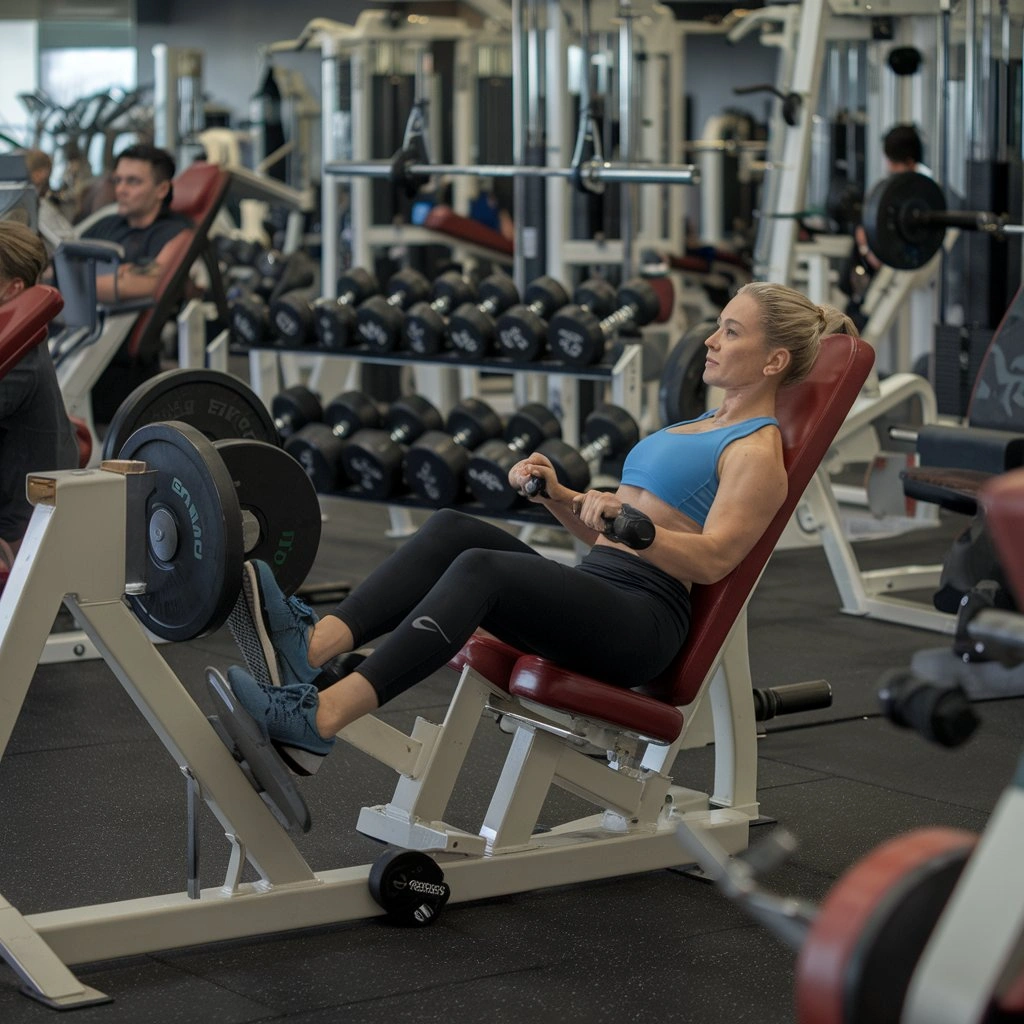Hey everyone, and welcome to the world of leg workouts! Today, we’re talking about a cool machine. You might have seen it at the gym (or even have it at home) – the leg press! This awesome piece of equipment helps you build strong, powerful legs.
Imagine being able to jump higher and run faster. You could also climb stairs without getting winded. That’s the magic of Leg Workouts! The leg press machine kind of looks like a fancy chair with a big platform for your feet. You sit down, adjust the weights, and then push the platform away with your legs.
It’s a simple idea, but it works those leg muscles! Now, using any gym equipment is important to do safely. Just like you wouldn’t want to ride a bike without knowing how to brake, proper form is key with the leg press too.
It helps you get the most out of your workout and avoids any ouch moments. In the next part, we’ll dive into some super easy tips to make sure you’re using the leg press like a pro!
Safety Precautions
We learned about the Leg Press Machine. But, before you start, let’s talk safety! Just like any exercise, proper technique is key to avoiding injuries and getting the most out of your workout. Here are some super easy tips to make sure you’re a leg press pro:
Warm Up Your Amazing Engine!
Think of your legs as a powerful engine. Before you put it to work with heavy weights, you need to warm it up! Just like a car needs a few minutes to get going smoothly, your muscles need a little prep too. Here’s a quick and easy warm-up routine:
- Do some Light Cardio to get your blood flowing. You can do jumping jacks, jog on the spot, or jump rope for 5 minutes.
- Dynamic Stretches: These stretches involve movement. Try leg swings, lunges, and high knees for a minute each.
- Light Leg Presses: Start with very light weights (or no weights at all) and do a few sets with perfect form. This gets your muscles used to the movement.
Finding Your Perfect Fit
Just like clothes, the leg press needs to fit you right! Here’s how to adjust the machine for a safe and effective workout:
- Seat Height: Sit comfortably with your back flat against the pad. When your feet are flat on the platform, you should bend your knees at a 90-degree angle. Adjust the seat so you can achieve this position.
- Foot Placement: Place your feet shoulder-width apart on the platform. Avoid putting your toes at the very edge of your heels way up high. A comfortable, flat placement is ideal.
- Weight Selection: This is where it gets exciting! But remember, it’s not about lifting the most weight. Start with a weight you can control through the entire movement. You can always increase the weight later as you get stronger.
Safety Clips: Your Built-in Bodyguards!
Many leg press machines come with safety clips on the sides. These are like your built-in gym buddies, there to help you out if needed. Here’s how to use them:
- Set the clips before you start your set. Put them below the lowest point you can reach with your legs. This way, if you get tired or struggle to push the weight back up, the clips will catch the platform. They will stop it from crushing your legs.
- Peace of Mind: Knowing the clips are there brings you peace. It lets you focus on your form and on pushing your limits safely.
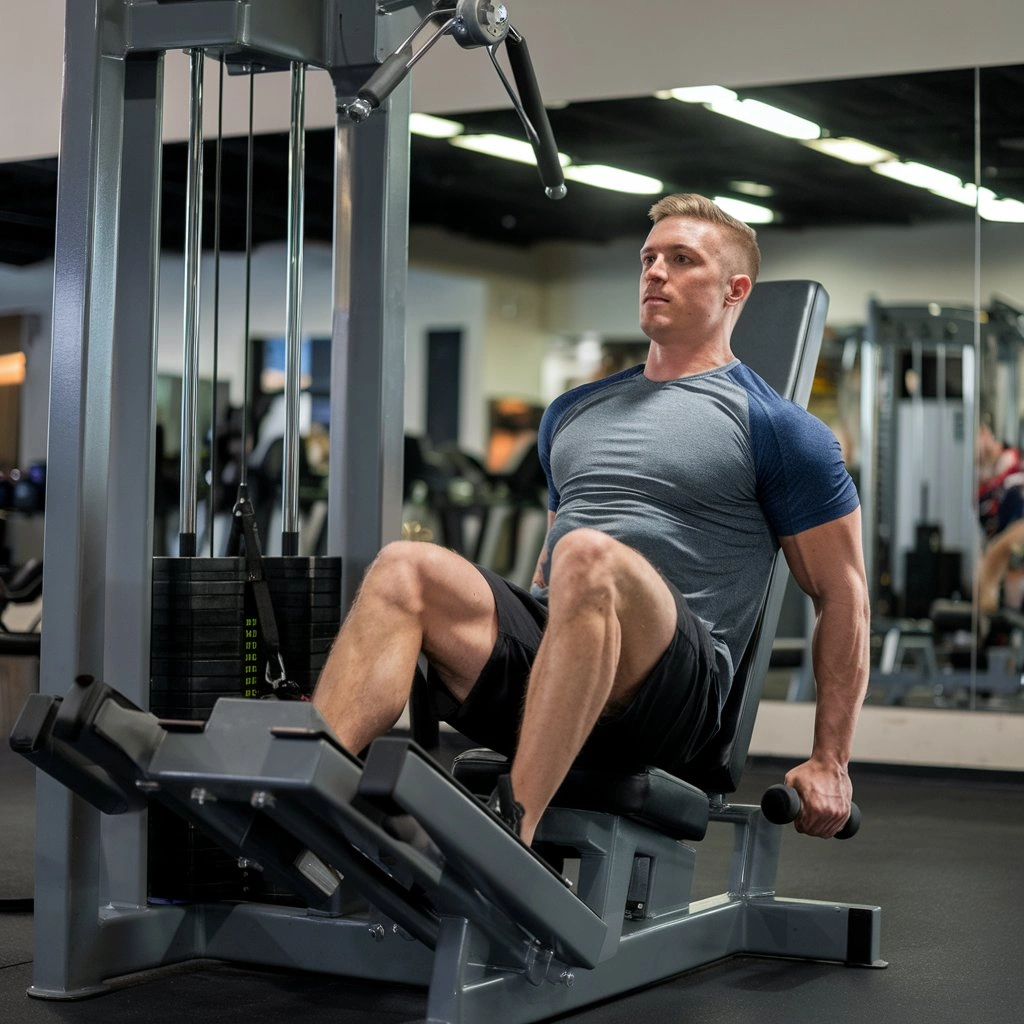 Proper Form and Technique
Proper Form and Technique
We’ve covered the cool factor of the leg press machine and the importance of safety. Now, let’s unlock the secret to using it effectively: proper form and technique! Here’s how to turn those leg presses into powerful leg builders:
Foot Placement: Finding Your Power Position
Your feet are the foundation for a strong leg press. Here’s how to position them for maximum benefit:
- Shoulder-Width Apart: Think about the width of your shoulders. Place your feet flat on the platform at this same distance apart. This ensures even pressure distribution and targets your entire quadriceps muscle group.
- Toe Angle: This one depends on your comfort level. Some people prefer a slight outward turn (think pizza slices, not airplane wings!). Others feel best with their toes pointing straight ahead. Experiment and find what feels most natural and stable for you.
- Heel Placement: Keep your entire foot flat on the platform, with your heels planted. Avoid having your toes way up at the edge or your heels way off the ground. This can put unnecessary strain on your ankles and knees.
Gripping the Handles: Your Anchors for Stability
Those handles on the sides aren’t there for decoration! They’re your anchors for stability. Here’s how to grip them properly:
- Find Your Grip: Your hands should positioned around the handles. A firm but relaxed grip is ideal. Avoid gripping them too tightly, as this can tense up your shoulders and take away from your leg workout.
- Keep a Straight Back. As you grip the handles, ensure your shoulders are down and relaxed. They should not be hunched up towards your ears. Keep your back naturally pressed against the seat pad throughout the entire movement.
Back to Basics: Flat is the Way to Go
Your back is the powerhouse that connects your upper body to your legs. Keeping it in the right position is crucial for safety and effectiveness:
- Flat is Fantastic: Throughout the entire movement, your back should be flat against the seat pad. Imagine pressing your lower back into the pad to create a nice, solid connection.
- No Arching Allowed: Avoid arching your back at any point during the leg press. This puts unnecessary strain on your lower back and can lead to injury. Remember, keep it flat and strong!
Slow and Steady Wins the Race
Think of the leg press as a controlled movement, not a weightlifting competition. Here’s how to find your perfect pace:
- Controlled Descent: As you begin the exercise, slowly lower the weight down towards your legs. Breathe in as you perform this movement. Aim for a controlled descent that takes about 2-3 seconds.
- The Power Push: Once your knees are bent at a 90-degree angle (or slightly lower if comfortable), exhale and push the platform back up to the starting position. Focus on using your leg muscles to drive the movement, not bouncing or jerking the weight. Aim for a controlled push that takes about 2-3 seconds as well.
- No Rush: Don’t try to go too fast. Focus on feeling the movement in your legs and maintaining proper form throughout the entire rep. Slow and controlled movements are more effective and safer than quick, jerky ones.
Locking Out: The Enemy of Strong Knees
Your knees are the hinges of your legs. Keeping them healthy is key! Here’s how to avoid locking them out during the leg press:
- The 90-Degree Rule: As you push the weight back up, don’t completely straighten your legs. Stop just before your knees lock out (become straight). This keeps tension on your quadriceps muscles and protects your knees from unnecessary strain.
- Maintain a Slight Bend: Aim to have a slight bend in your knees at the top of the movement. This allows for better control and prevents hyperextending your knees, which can lead to injury.
Common Mistakes to Avoid
The leg press is a fantastic machine for building strong legs, but even the best tools can be misused. Here are some common mistakes to watch out for so you can get the most out of your leg press workouts and avoid any ouch moments:
Crumbling Knees: Keeping Your Form Strong
Imagine your knees as strong pillars. During the leg press, you want to keep them in a perfectly straight line:
- The No-Cave-In Zone: As you push the weight, avoid letting your knees cave inwards towards each other. This puts unnecessary stress on your knee joints and can lead to injuries. Focus on pushing your knees outwards slightly, keeping them in line with your toes.
- Mind Your Muscles: When your knees cave in, it takes away from the work your quad muscles should be doing. By keeping your knees aligned, you’ll be targeting the right muscles and getting a more effective workout.
Back Off the Arch: Keeping Your Spine Happy
Your back is your body’s core, and keeping it healthy is crucial. Here’s how to avoid arching it during the leg press:
- Flat is Your Friend: Remember the “flat is fantastic” rule from proper form? It applies here too! As you push the weight, avoid arching your lower back off the seat pad. This puts a strain on your spine and can lead to pain or injury.
- Engage Your Core: Instead of arching your back, think about engaging your core muscles. This will help stabilize your spine throughout the movement and protect it from injury. Imagine pulling your belly button inwards towards your spine as you perform the leg press.
Momentum Mayhem: Slow and Steady Wins the Race
The leg press is about controlled movements, not launching yourself into space! Here’s how to avoid using momentum:
- Ditch the Jerks: Avoid bouncing or jerking the weight up and down. This uses momentum instead of your leg muscles and can lead to loss of control and potential injury.
- Slow and Controlled: Focus on slowly lowering the weight down (breathing in) and then pushing it back up (breathing out) in a controlled manner. Aim for a smooth, steady motion throughout the entire rep.
- Feel the Burn: Don’t be afraid to use lighter weights if needed. The goal is to feel the movement in your legs, not use momentum to lift heavier weights. You’ll get stronger and be able to increase the weight gradually over time with proper form.
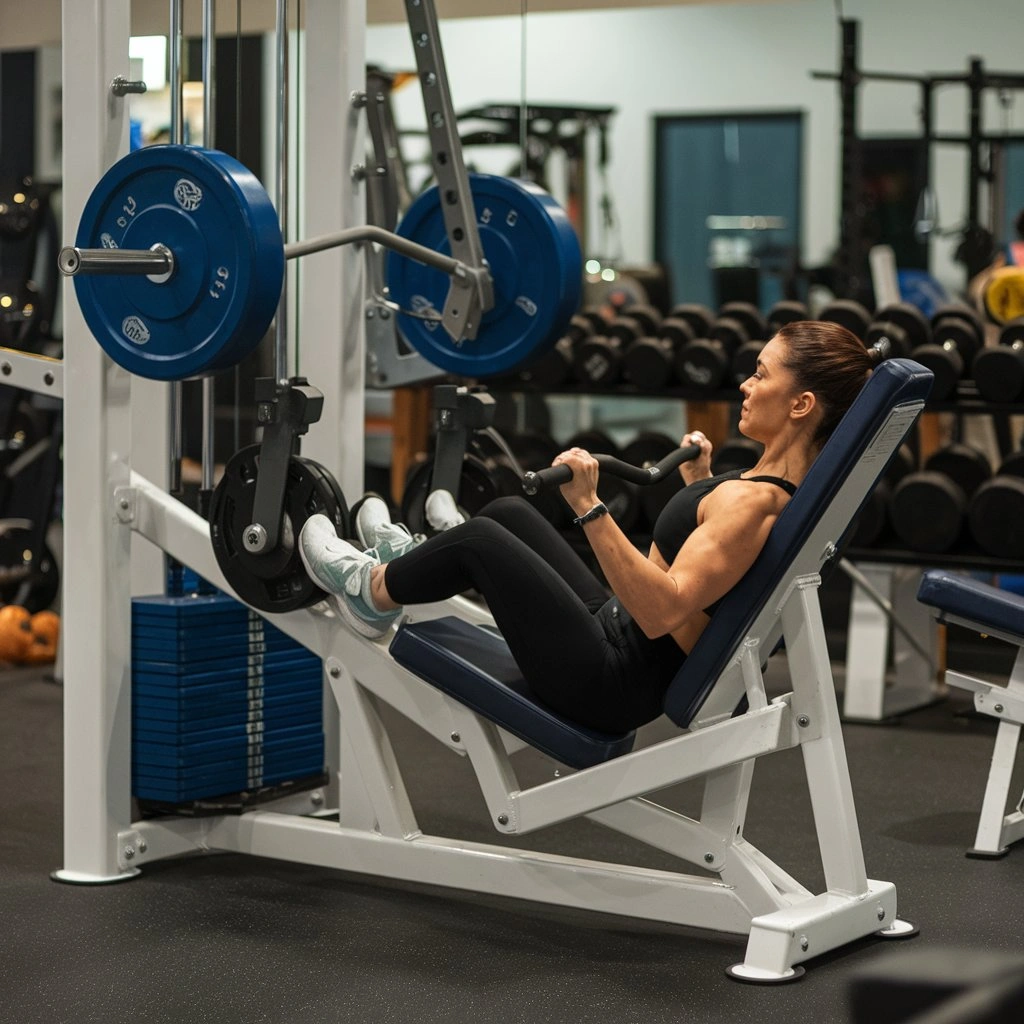 Variations and Modifications
Variations and Modifications
The leg press is a great machine, but who says workouts can’t be fun and challenging? Here are some variations and modifications to spice up your leg routine and target different muscle groups:
Foot Placement Finesse: Targeting Different Areas
The way you position your feet on the platform can make a big difference in which leg muscles you target:
- High Foot Placement: Want to feel the burn in your glutes and hamstrings? Place your feet higher up on the platform, closer to the top. This shifts the emphasis away from your quads and works your backside muscles more intensely.
- Low Foot Placement: Feeling quad-focused? Put your feet lower down on the platform, closer to the bottom. This increases the activation of your quadriceps muscles and gives them a targeted workout.
- Narrow Stance: Inner thigh feeling neglected? Try a narrow stance with your feet closer together than shoulder-width apart. This engages your inner thigh muscles (adductors) more and adds a new challenge to your routine.
- Wide Stance: Want to work your outer thighs? Go wide! Place your feet further apart than shoulder-width on the platform. This activates your outer thigh muscles (abductors) and adds stability to the movement.
Single-Leg Press: The Ultimate Strength Test
Feeling strong? Take your leg press game to the next level with single-leg presses:
- Unilateral Challenge: Instead of using both legs together, try pressing the weight with one leg at a time. This increases core engagement for stability and challenges your leg strength individually. It’s a great way to identify and address any imbalances between your left and right leg.
- Start Light: Single-leg presses require more balance and control. Start with a lighter weight than you would use for a regular leg press to ensure proper form and avoid injury.
Resistance Band Bonanza: Kicking Up the Intensity
Want to add some extra oomph to your leg press workout? Resistance bands can be your new best friend:
- Band Boost: Loop a resistance band around the platform at the bottom and the top of the machine. This creates added resistance throughout the entire movement, making it more challenging and forcing your leg muscles to work harder.
- Variety is Key: You can experiment with different band placements to target different parts of the movement. For example, try looping the band higher up for more resistance at the top of the push, or lower down for more resistance at the bottom.
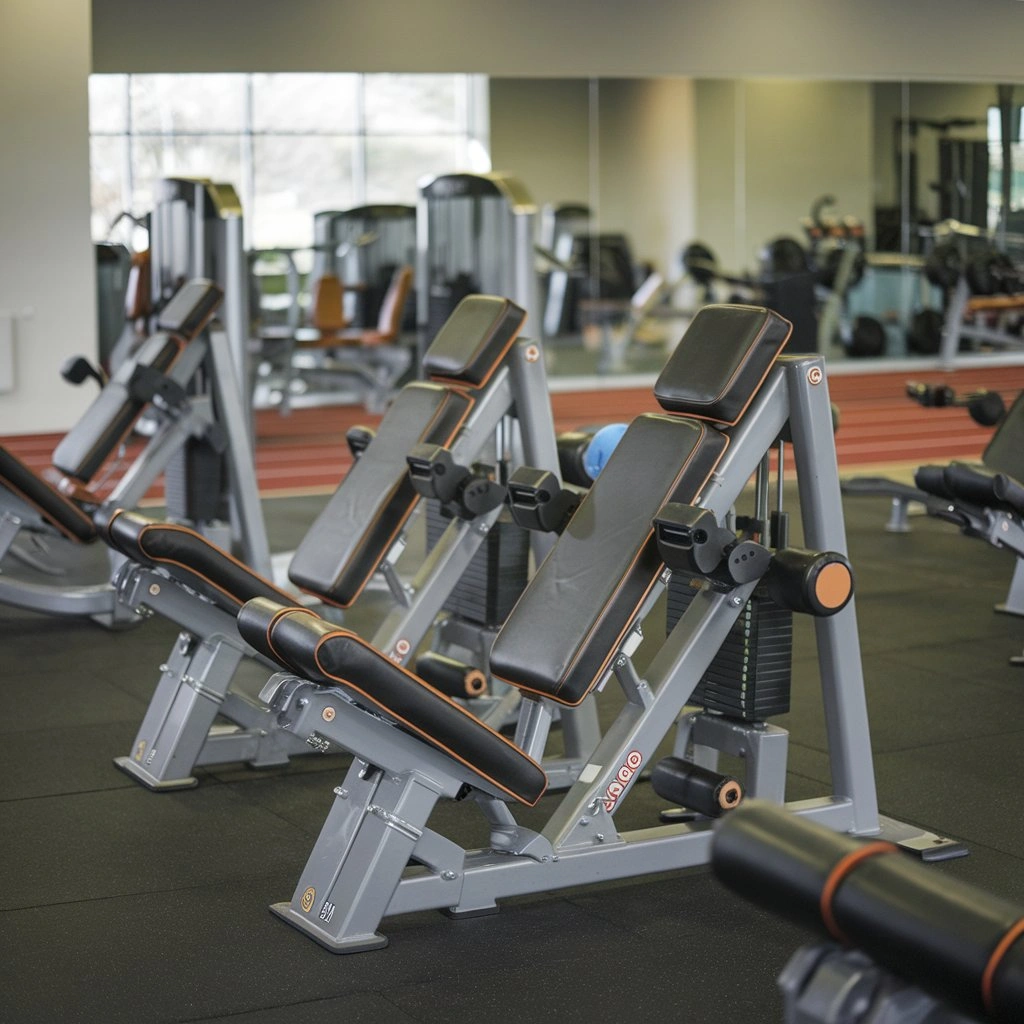 Benefits of Using the Leg Press Machine
Benefits of Using the Leg Press Machine
The leg press machine is a gym favorite for a reason! This versatile piece of equipment offers a range of benefits for people of all fitness levels. Let’s explore why the leg press should be a part of your leg workout routine:
- Building a Strong Foundation: The leg press effectively targets major leg muscles like your quadriceps (quads), hamstrings, and glutes. Strong legs are essential for everyday activities like walking, running, climbing stairs, and even maintaining good posture. By strengthening these muscles, you’ll move with more power and confidence.
- A Safer Squat Alternative: Squats are a fantastic leg exercise, but they can be challenging or put a strain on your lower back, especially for beginners. The leg press offers a safer alternative that still allows you to build serious lower body strength. The controlled movement and back support make it easier on your joints, reducing the risk of injury.
- Rehab and Recovery Partner: The leg press is a valuable tool for physical therapy and rehabilitation. The adjustable weight allows you to gradually rebuild strength and flexibility after injuries. The controlled movement is ideal for those recovering from knee or ankle issues, allowing them to safely regain leg strength without putting undue stress on the joints.
Sample Workout Routine
Ready to build those strong, sculpted legs you’ve been dreaming of? Look no further than the leg press! Here’s a sample workout routine that will get your legs burning (in a good way!) and help you achieve your fitness goals:
Warm Up Your Engine (5-10 minutes)
Just like a car needs a warm-up before hitting the highway, so do your muscles! This gets your blood flowing and prepares your body for the workout ahead. Here are some great warm-up options:
- Light Cardio: Get your heart rate up with some light cardio exercises like jumping jacks, jogging on the spot, or jumping rope for 5 minutes. This increases blood flow and warms up your leg muscles.
- Dynamic Stretches: These stretches involve movement and help loosen up your joints. Try leg swings, lunges, and high knees for a minute each. These stretches prepare your muscles for the full range of motion they’ll experience during the leg press exercise.
Leg Press Power (3 sets of 8-12 reps)
Now it’s time for the main event – the leg press! Remember the proper form and technique tips we discussed earlier. Here’s how to structure your leg press sets:
- Sets and Reps: Aim for 3 sets of 8-12 repetitions. This rep range helps build muscle strength and size. Choose a weight that allows you to maintain proper form throughout all the reps in each set. If the weight feels too light, increase it slightly for the next set.
- Focus on Form: Remember, slow and controlled movements are key. Breathe in as you lower the weight down, and breathe out as you push it back up. Keep your back flat against the pad, core engaged, and knees tracking in line with your toes.
- Rest Between Sets: Allow yourself 30-60 seconds of rest between sets. This gives your muscles a chance to recover before the next set.
Leg Blast Bonus (Optional)
Want to take your leg workout to the next level? Here are some additional exercises you can add after the leg press:
- Leg Extensions: This exercise targets the quadriceps (quads) in your thighs. Sit on a leg extension machine and straighten your legs against resistance.
- Leg Curls: This exercise works your hamstrings, and the muscles on the backside of your thighs. Sit on a leg curl machine and curl your heels towards your glutes against resistance.
Cool Down and Stretch (10 minutes)
Don’t forget to cool down after your workout! This helps your body return to its resting state and reduces muscle soreness.
- Light Cardio: Do some light cardio for 5 minutes, like walking or slow jogging.
- Static Stretches: Hold static stretches for your lower body muscles like quads, hamstrings, calves, and glutes for 30 seconds each. This helps improve flexibility and prevent injuries.
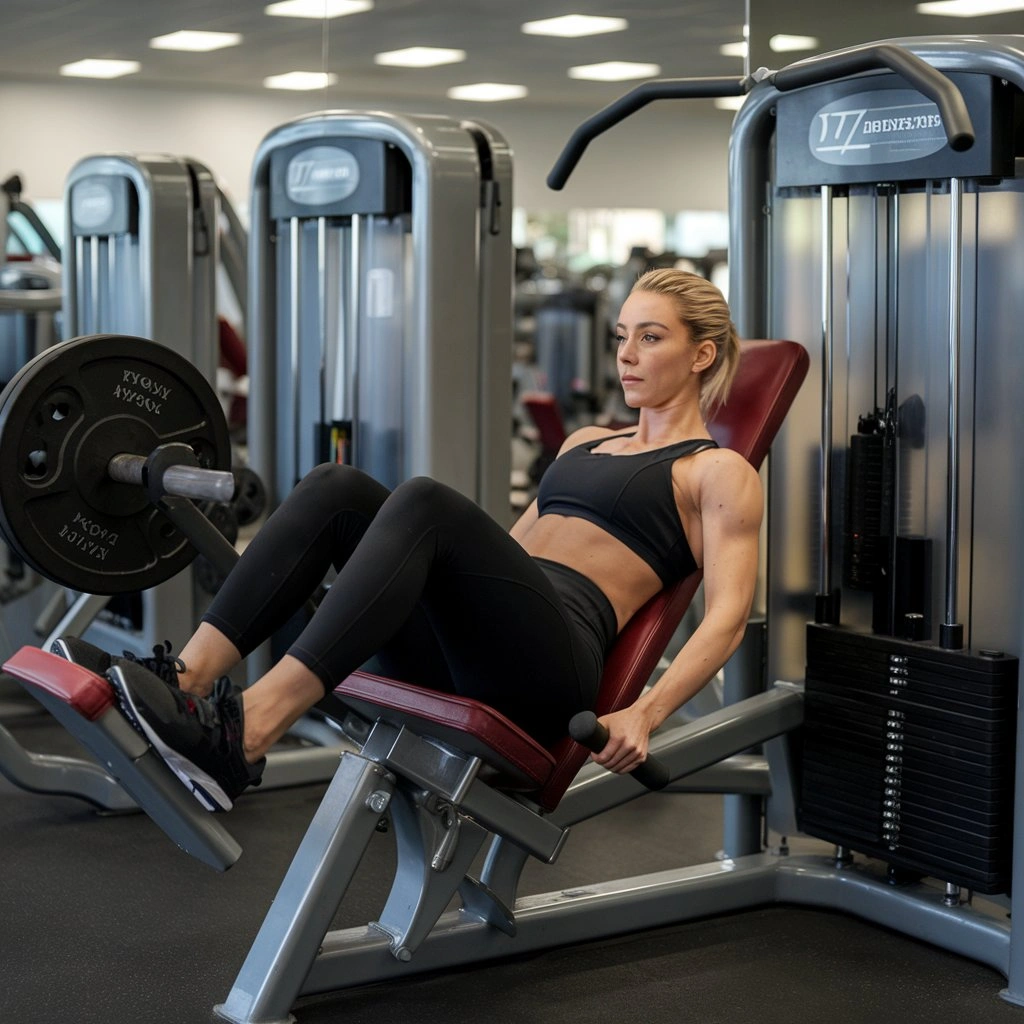 Conclusion
Conclusion
The leg press machine is no longer a mystery! We’ve explored its potential, from mastering proper form and safety precautions to exciting variations and a sample workout routine. Here’s a quick recap to solidify your leg press knowledge:
- Muscle Powerhouse: The leg press effectively targets your quads, hamstrings, and glutes, building a strong foundation for your entire body.
- Safety First: Remember, proper form and technique are crucial to avoid injuries. Focus on a flat back, controlled movements, and proper foot placement. Don’t hesitate to use the safety clips for added peace of mind.
- Variety is Key: Spice up your leg press workouts with different foot placements to target specific muscle groups. Experiment with single-leg presses and resistance bands to keep things challenging and fun.
- Benefits Beyond Strength: The leg press offers a safe alternative to free-weight squats and can be a valuable tool for rehabilitation, allowing for controlled movement and gradual strength rebuilding.
The leg press is a fantastic addition to your leg workout routine, but remember, it’s just one piece of the puzzle. Here are some additional thoughts to keep you on track:
- Balanced Routine: While the leg press builds strong legs, don’t neglect other muscle groups. Incorporate exercises for your upper body, core, and back to create a well-rounded fitness routine.
- Listen to Your Body: Start with lighter weights and gradually increase the intensity as you get stronger. Don’t push yourself beyond your limits, and take rest days to allow your muscles to recover.
- Seek Expert Guidance: If you’re unsure about proper leg press technique or have any limitations due to injuries, don’t hesitate to consult with a certified personal trainer or physical therapist. They can guide you on proper form and create a personalized workout plan that’s safe and effective for you.

